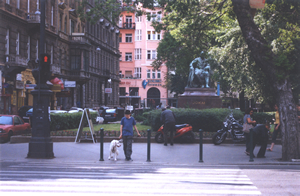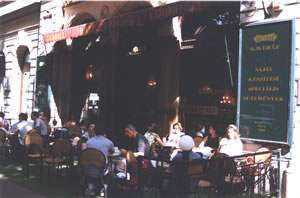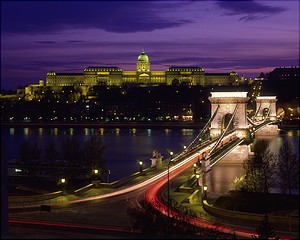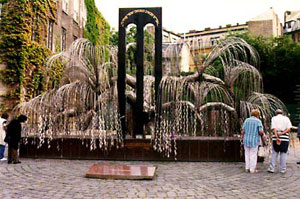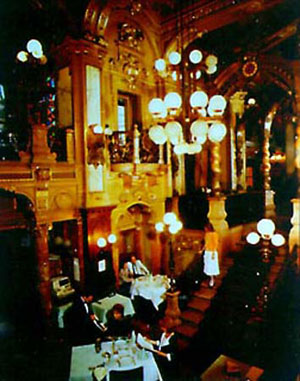 |
|
|
|
|
|
|
|
|
|
|
|
|
|
|
|
|
|
|
|
|
|
|
|
|
|
|
 |
 |
|
|
|
|
|
|
|
|
|
|
|
|

|
Budapest Revisited And a River Runs Through It wasn"t so many years ago that traveling to London for a long weekend was limited to jet-setters. More recently, flying to Paris, Madrid or even places farther away did not seem too indulgent. Now thanks to direct 8-hour flights from New York, Budapest can be added to the list of great cities where a long weekend is a lark.
After a comfortable overnight flight in Business Class and a short nap we went off on foot to explore the great walking city we visited in 1999 and were so taken with. From the Pest side we strolled on Szent Istvan korut, a boulevard lined with shops and restaurants affording an instant glimpse of social and commercial life in the capital, and headed toward Margit Bridge to Buda on the opposite side of the Danube. Before merging in 1873 Buda and Pest had been separate municipalities. The view of the river from the bridge is a beautiful one. Boats wait in ready to take passengers on short spins so they can view both banks or outside the city limits from which a return trip on the suburban railway is possible. The Spoon Café, a restaurant operating on a docked vessel, is visible from this point and is a lovely place to lunch. For greener hikes than the streets permit, exit at the middle of the bridge onto Margit Island, a park dissecting the river and filled with bucolic paths. Or if you are up to the challenge you can continue to the end of the overpass, go south along the Danube to explore the very hilly Castle district. The Castle Bus transports visitors to the district. Wandering in the old quarter you discover at every turn a beautiful façade, a square or an alley filled with history. The House of Wine, Szentharomsag ter 6, stores about 450 varieties from the country"s 22 wine regions. Visitors to the cellar can taste 70 to 80 vintages. Beneath the Castle lies one of the most interesting attractions in the district, the Labyrinth, a complex of caves whose walls are covered with copies of Europe"s celebrated cave paintings and with scenes of Hungarian and world history. Enter via the stairs at Uri u. 9. Using an oil lamp, you can tour the Nighttime Labyrinth between 6 and 7:30 pm. Our itinerary said "surprise” under the listing. In the Renaissance Hall of Rocks stands a pillar decorated with fountains from which red wine gushes. It is the real McCoy. After the fall of the Iron Curtain in Eastern Europe most countries destroyed the symbols of that era. Rather than melt down the bronze or chop up the stone statues lining the streets and squares of the capital and other parts of the country, the new government collected and shipped them to South Buda. Here in Statue Park, an outdoor museum, one finds oversized sculptures from the communist times: Lenin, Marx and Engel"s, Bella Kun, soldiers saluting and the citizenry with their arms outstretched and waving flags.
The most commanding building on the Pest side of the river is the neo-Gothic Parliament looking much like a cathedral. With almost 700 rooms, most of them off-limits, it is the largest building in the country. Open to the public are the grand staircase embellished with sculptures and beautiful frescoes as well as the congressional chamber. The Crown of St. Stephen, dating from the 12th century, rests here. Legend, however, says that it was presented to Stephen in 1000 by the Pope. Many regard the crown as the symbol of the Hungarian nation. A large black marble stone with an eternal flame stands outside the Parliament in Kossuth Square as a memorial to the 25,000 who fell during the 1956 uprising against the Russian-controlled regime. Symphonic city that it is, you can hear Liszt, Brahms, Haydn and Bartok every night in churches and concert halls. Our hosts strayed from the classical and took us to Jazz Garden, a restaurant with mediocre food and great music. Featured that evening were the rhythms of Brazil with an energetic band and singer belting out songs from 8:30 into the night. To hear a preview of a program log on to http://www.jazzgarden.hu Atop our list of things to do was to attend a performance at the State Opera House, Andrassy ut. 22. We were told at the box office and during a tour of the house that seats had been sold out for many months. The opera house is a 19th-century marvel and is richly decorated like a palace with frescoes on the ceiling of Apollo and other Greek gods cavorting, playing and listening to music. With perfect acoustics, the opera is considered one of Europe"s finest. For narcissistic reasons of his own Emperor Franz Joseph, who was ruler in 1884 when the building was completed, insisted that it be smaller than the one in Vienna. Opera House tours daily at 3 and 4 p.m. Tel. 332-8197. Our perseverance paid off. We did get to hear Othello that evening. Late in the afternoon the concierge at the hotel secured second row seats for $55 each, a fraction of what we would pay at the Met. We enjoyed the experience of being part of an enthusiastic audience, but the performance was disappointing. The sets were uninspired and the singers merely adequate. They brought no passion to their roles.
After the opera or a tour of the house stop at Muvesz, a typical Eastern European coffee shop, where artists, writers and musicians gather to socialize. Located at Andrassy ut 39, on the city"s chicest thoroughfare, its sidewalk tables are great for people watching. Budapest"s most famous café is Gerbeau. The fine old building, dating from 1858, is known as a Konditorei and Kaffeehaus, but it also has a restaurant, pub and take-out shop in its several interconnected rooms. The two main rooms face Vorosmarty Square in the heart of the city. Gerbeau is for people who like ornate surroundings and a buzz with their baked goods. Since Roman times or possibly earlier spa water has been plentiful in the Budapest. Adjoining City Park and close to the zoo, amusement park, Municipal Grand Circus, Vajdahunyad Castle and two museums, Szechanyi Thermal Baths is the largest in the city. Built in 1913 and enlarged several times since, the complex holds three swimming pools, numerous open-air mineral pools, which attract the hearty even in winter, indoor tubs and rooms for massages. Three chess boards are mounted in one pool so that guests can play and soak simultaneously. The baths are medicinal because of the calcium, magnesium and hydrogen in the carbonic sulphur water springing from the area"s deepest and hottest wells. Other popular spas are: Gellert furnished in the original Art Noveau style, Lukacs for its therapeutic water, Kiraly and Rudas with their Turkish features and Helia and Thermal Hotels on Margit Island because of their quiet locations. On our previous trip we never ventured outside the city. Szentendre (St. Andrew) is the logical choice for picturesque and easy (30 to 40 minutes by train) excursion. Our privately arranged car passed ruins--the foundation of barracks and the remnants of a coliseum--from the days when this stretch of the Danube was for hundreds of years the northern border of the Roman Empire as they held the Barbarians at bay. Located at the Danube Bend, Serbs fleeing the Turks founded the village in the 17th century. Although, the Serbs returned home their presence remains in the architecture. In the early 1900s sculptors and painters started to move to St. Andrews. Their work appears in the many galleries, studios, and museums.
At the skanzen or the Open-Air Ethnographic Museum, about three kilometers from St. Andrew, docents demonstrate in reassembled old rural structures the techniques used by peasants to make wine, bread and cloth. Fully furnished homes are decorated with period furniture and household implements. Stables have the necessary equipment for animal husbandry. The working windmill illustrates how farmers created energy. Before returning to the city we stopped for lunch at Promenade, a restaurant, tavern and inn close to the town center and housed in a 400-year old restored building. The kitchen serves excellent Hungarian dishes. We began with goulash, which the owner explained is truly a soup like the one he serves rather than a stew. The chicken entrée was tasty, but the true piece de resistance of the meal was dessert—Gundel palacinki, crepes with chocolate sauce and ice cream. It"s one of those desserts where after tasting one bite, you feel compelled to finish it all. Lunch ended with a tasting of local wines in the building"s ancient subterranean cellar. Hungarian wines, not bad at all. In fact, many are rather good. Futo ut 4 Dunakorzo. Where to Stay The recent lifting of American sanctions against Libya brought to an end the American embargo by U. S. companies and citizens of the Corinthia Group, owner of the Corinthia Grand Royal Hotel. Originally built in 1896 as the Grand Hotel Royal, it has been completely renovated and modernized while retaining its royal features. An empire façade, domed roofs tiled in black, a marble-floored entrance hall flooded with natural light leading to a sweeping staircase, molded ceilings, sculptured columns and gold statues, and a glass roof covering the central atrium. Comfortable, attractive, spacious rooms, good food and outstanding service merit the five-star designation. The fitness center and spa had not yet been completed during our stay. To use similar facilities, the hotel sent guests to the sister property, Corinthia Aquincum in a complimentary car. Erzsebet krt. 43-49. Tel. 36-1-479-4000. http://www.corinthiahotels.com
Fifteen years after the demise of communism in Hungary, there is a rush to build more luxury hotels, the ultimate emblem of capitalism. Four Seasons Hotel Greshem Palace Budapest, an Art Noveau gem at the foot of the Chain Bridge, just opened A cadre of craftsmen painstakingly restored the original treasured features--soaring winter gardens, stained glass, mosaics and intricate iron works. Roosevelt ter. 5-6. Tel. 31-1-268-6000. The New York Café, a Budapest institution since 1895 closed to freshen its elegant turn-of-the-century décor and remodel the top floors. The space inhabited by newspaper offices in years gone by is being converted into hotel rooms. At noontime reporters met in the café at the base of the building. Because of the New York"s traditions, the literati will no doubt return when the doors reopen. How To Reach Budapest Malev Hungarian Airlines flies directly to Budapest from New York leaving JFK most nights at 8:10 p.m. and arriving 11:55 a.m. local time. In New York, Malev shares Swiss Airlines lounge, which is more comfortable and spacious than it own Budapest lounge. Food in Business Class was good. The Hungarian specialty, braised breast of goose, was surprisingly tasty since it was devoid of fat, but was not dry. We try not to drink alcohol on flights, but who could turn down a chance for a private tasting of Hungarian wines--sips of two hearty reds, two distinctive whites and one sparkling from the champagne family on the wine list. All were outstanding. For more information log onto http://www.gotohungary.com Spring 2004 Budapest Gypsy Songs, Strudel and Spas In less than two hours after we arrived in Hungary's capital, we made it to the departing point for a Grand City Tour. Following our custom of signing up for a tour as a first activity in a new city, we asked the concierge to schedule one. We dropped off our luggage, grabbed a snack and hopped a taxi. Sounds great? It wasn't. Once more we seem to have struck out. We've not sworn off tours, more about that later, but this one, organized by Cityrama, was weak because it was conducted in two languages and did not offer an opportunity to ask questions.Despite the guide, we instantly fell in love with Budapest, a city stitched together by the storied Danube, coursing green and hilly Buda and flat Pest where the Hungarian Plain starts. The bus took off in Pest and the introduction to major sites began with the cupolaed, turreted, filigreed neo-Gothic Parliament, the second largest seat of government in Europe. Graceful suspension bridges span the river, the oldest one being the Chain, which opened in 1849. Crossing the Margaret Bridge we glimpsed the mile-and-a-half-long, boat-shaped Margitsziget, a lush island oasis in the Danube with restaurants, pools, cafes, gardens and a thermal springs hotel. Passing St. Anna Church, reputed to be the most beautiful church in Hungary, and the 400-year-old Turkish Kiraly Spa, which is still in use, the motor coach climbed to the city's showpiece, Buda's Castle District. The final ascent requires another climb, this time on foot, but the work of artists plying their craft on the stairs distracts from any huffing and puffing on the way up. At another time use the funicular to reach the top.
If our initial tour was a disappointment, a second one, "Jewish Cultural and Musical Heritage in Budapest,"lasting four and one-half short hours, more than made up for it. Participants representing different nationalities and religions seemed awed and entertained by the many activities--a visit to one of the most beautiful synagogues in the world, the Dohany Street Synagogue, several renditions by a cantor, a lecture by the erudite director of the Jewish Museum, a viewing of the Tree of Life sculpture in Raoul Wallenberg Park, a tasting of traditional Eastern European Jewish food at the Carmel Restaurant and a one-hour Budapester Klezmer Band concert. Klezmer music, originating in Eastern Europe, is often referred to as Jewish jazz. The seven-piece ensemble lives up to its reputation as the best Klezmer band in the world.
To duplicate the charm of the Paris metro, ride the yellow line. Its renovated stations--this underground opened in 1896--may remind you of the one at the Louvre for the stops along the route are filled with photographs and displays. The dark wood and gleaming white tiles have a turn-of-the-century look. Get off at Heroes' Square to see the Museum of Fine Arts and the Zoological and Botanical Gardens, to linger at a cafe, to stroll in City Park or to soak up the late 19th-century atmosphere. From the square, stately Andrassy Street, looking much like a diplomatic row, runs straight into the heart of Pest. Reboard the metro to visit the glorious State Opera House and St. Stephen's Basilica where an ethereal radiance seems to hover above the reverent visitors. Hungaria Koncert Kft. (Zrinyi utca 5, tel. 36-1-317-2754, 36-1-317-1377) combines its programs--opera galas, gypsy concerts, folk groups--with post-performance dinner cruises. The spirited singing and dancing by the Hungarian State Folk Ensemble and the boat ride on the Danube were enjoyable. From the river the brooding city glowed with twinkling lights and the imposing public buildings could be observed from a new perspective. The cold buffet was unappealing, but there's little to complain about, since Hungaria Koncert Kft. fed us well on the "Heritage" tour. Budapest has a Madison Avenue counterpart in Vaci utca, a sizable pedestrian mall of chic shops and smart cafes where it is fun to idle, particularly in late afternoon. The nearby square, Vorosmarty ter, is crowded and free of cars. Because historical buildings were destroyed during the wars and sieges, Budapesti compensate with statues and monuments commemorating public figures. The one of Stalin, along with others from the days when the Soviets controlled Hungary, have been consigned to one park. Honors have even been bestowed upon Madonna. Our hotel room overlooked Elizabeth Square where amid the horse chestnut trees there is a plaque marking her performance in "Evita." The two- or three-day Budapest Card, good in museums and on public transportation, is a bargain. It often saves you from reaching for your wallet to pay in a currency that you may have difficulty mastering. The card is also good for discounts at shops, restaurants, cultural events and spas. Taxi drivers have been known to take passengers for rides in more ways than one, so be forewarned. Another caveat: The Danube isn't blue, but the azure sky hanging over the water helps you pretend that it is. WHERE TO STAY We were certain when we made reservations that we wanted to book the Kempinski, the classiest inn in town. Knowing nothing about the pros and cons of staying in Buda versus Pest, we serendipitously chose correctly and ended up in Buda. The location is ideal, since it is only steps from Vaci utca.A modern hotel, the Kempinski tops the list of the city's deluxe hostelries and is the only member of The Leading Hotels of the World in Hungary. The rooms are attractively decorated with Biedermeier furniture. Spacious bathrooms have under-the-floor heating. After tiring days of sightseeing, we appreciated the snug beds and down pillows and were asleep after barely pulling up the featherbed covers. Although it is only a small touch, we were pleased to find items like paper clips, scissors and Scotch tape in a desk drawer. But, best of all was the outstanding concierge staff. They made phone calls to change dinner reservations, mailed postcards, gave directions and were very tuned in to helping us get the information we needed. Kempinski Hotel Corvinus, Erzsebet ter 7-8. Tel. 800-426-3135, 36-1-429-3777. Rates begin at $330. www.kempinski-budapest.com WHERE TO DINE Hungarian food, influenced by centuries of foreign occupation, sparkles. Unlike that of some of its neighbors, the food is not all pork and dumplings. Fortuna, rated as one of the 10 best restaurants within the country's borders by Zagat's counterpart in Hungary, is a case in point.The meal began auspiciously with a plate of tantalizing cold hors d'oeuvres: smoked trout on celery remoulade, braised fogas, a delicate fish, marinated cured venison and apple and game salad. Next came lively white duck soup swimming with slivers of breast meat, quail egg and tokay grapes. Entrees were assembled with harmony and were not unnecessarily fussy. Flavors were never less than clean. Prune-stuffed turkey breast was napped with cheese sauce and succulent goose breast was teamed with light and eggy spaetzle. Housed in a 14th-century building whose lower level was once a jail with thick stone and brick walls that are still intact, the downstairs is filled with whimsy. Brightly painted manikins of jesters and animals give the eye a merry ride. Champagne is prized at Fortuna and patrons are invited to the generously stocked cellar for tastings. Fortuna Restaurant, Hess Andras ter 4. Tel. 36-1-175-6857 Open seven days, lunch and dinner. Very expensive. www.directinfo.hu/fortuna/aindex.html The concierge gave us the requested brochure for Kiraly and then suggested that it might be touristy, since wisdom has it that food in a restaurant with entertainment is usually poor. The concierge was mistaken. With lace tablecloths, Herend china, fine appointments and food to match, this intimate dining room is just the place to sup while rousing gypsy tunes are being played. And that is what five musicians do non-stop. The singers and dancers couldn't have made it on Budapest's Broadway, but they were, nonetheless, amusing. For openers there were slices of slightly fatty robust salamis and savory pâtes. Main courses of tender venison and beef were beautifully cooked and accompanied by a duet of rich sauces and appropriate garnishes like cranberry stuffed pears and wild mushrooms. Desserts featured several famous pastries. What to choose? Every bite of chestnut strudel with apricot ice cream and apricot custard was impossibly celestial. The circular-shaped dining room with its stained glass dome is hung with oil portraits that look as though a Hungarian Thomas Benton might have painted them. They don't quite fit the classic decor. Kiraly, Tancsics Mihaly utca 25. Tel 36-1-212-8565. Open seven days. The show starts at 9 p.m. Very expensive. www.kiraly-restaurant.hu There are no off nights at the 300-seat Magnaskert located far from the city's center on Rose Hill. On a Monday evening every table was taken by Budapesti. But with four private rooms--winter garden, wine cellar, champagne bar and Sissi hall--diners are not aware that they have so much company. Looking like a chalet in the woods, the restaurant is rustic, romantic and cheerful and has a covered terrace and splendid atrium in the center. Floor-to-ceiling windows look out on the garden. Walls are brick or wood paneled. The food shines. With 80 items on the menu, decision-making was difficult, but it turned out that we chose well. Cognac-laced oxtail soup and lamb-stuffed zucchini in rosemary sauce were heady starters. Plates are heated at the table. Veal medallions with wine mousse, baked peach and a sauce similar to Bearnaise and venison with hazelnut sauce and blackberries were stylish renditions of updated classics. And for dessert, could anything have been better than rum flavored plum nut strudel topped with cinnamon sauce? Magnaskert owns vineyards in Lake Balaton and produces three private label vintages. A gypsy band entertained continuously and without missing a beat took requests for popular tunes from all over the world. Restaurant Maganskert, Csatarka utca 58. Tel. 36-1-325-9967. Open daily, lunch and dinner. Expensive. Coffee houses are an important part of the social life of the city. People gather here not just to enjoy coffee and famously rich cakes, but to exchange the news of the day. Dating from 1895 with a magnificently preserved interior, the New York Cafe still draws the town's literati, who come here to eat pastries and ice cream and to listen to music in the afternoons. The keys were ceremoniously tossed into the Danube as a gesture that the cafe would never close its doors. New York Cafe, Erzsebet koru 9-11. Tel. 36-1-322-3849. Open daily. Moderate. Spring 1999 |
||||||||||||||||
